The Carburetor Shop LLC
204 East 15th
Street
Eldon, Missouri 65026
Home | History | F.A.Q. | Orders | Contact Us | SELL TO US
Carburetors | Repair Kits | Other Parts | Literature | Tools | Articles | Troubleshooting | Carburetor
Identification
Passenger Kits | Truck Kits | Tractor Kits | Industrial Kits | Marine Kits | Multi-carb
set-ups
Car Comics | Car Records | Car Trading Cards | Subscription Cards | Oakland
and Pontiac
VIRTUAL
MUSEUM OF CARBURETORS
WELCOME!
The Carburetor
Shop has been acquiring unusual carburetors and related items for almost 50
years. We have enjoyed having our customers and other interested parties tour
our shop for a long time. However, thanks to new local government and
insurance regulations we are now mail order only and can no longer offer
tours of our shop, so have decided to continue to share some unusual items
with enthusiasts via the internet. It should be noted that this is not a
comprehensive history of any company, rather a sampling of carburetor
history.
ADMISSION
If you enjoy the
tour, we ask only that you share the link with someone younger than yourself.
So let's get
started! The tour is loosely arranged via carburetor manufacturing companies,
and accessory manufacturing companies. Obviously, there is some overlap.
CARBURETOR MANUFACTURING COMPANIES
Autolite | Carter | Detroit | Ensign | Holley | Kingston | Linkert | Marvel | Motorcraft | Rayfield | Rochester | Schebler | Stromberg | Tillotson
| Winfield | Zenith
Lesser known
carburetor brands
CARBURETOR ACCESSORY
MANUFACTURING COMPANIES
Ballwin-Washington | D & G | Hawk | Hygrade | Parker Brothers | Sherman | Vernay
Autolite /
Motorcraft
Autolite/Motorcraft began selling carburetors in 1957, primarily to Ford
Motor Company. A.M.C. also used Motorcraft carburetors in the late 1960's and
1970's. Autolite would place a Ford tag on carburetors purchased from Carter,
Holley, and Rochester; so many carburetors with a Motorcraft tag actually
were made by other companies
Carter
One of the older carburetor companies in the USA, Carter started selling
carburetors about 1909. While Carter sold to a number of smaller car
manufacturers in the 1910~1920 period, Chevrolet in 1923 was Carter's first
big customer. Carter was extremely successful after 1923, and by the late
1930's, according to some sources, had more than half of the carburetor
business in the USA. After Penberthy quit producing the Ball & Ball
design, Carter acquired the rights to produce this design from 1933 through
the late 1960's. Carter introduced the W series in 1931 with the W-2 used by
Nash. The W series went through the W-0, W-1, WA-1, WE, W-2 single barrel
carbs, the WD-0, WCD, and WGD two-barrel carbs, and the WCFB four-barrel
carbs. In 1950, the Y series was introduced. The Y series consisted of the
YF, YH (horizontal) and YS (sealed) single barrel carburetors. Carter also
produced the BBS (single barrel) and BBD (two barrel carburetors). In 1957,
Carter introduced the AFB 4-barrel which became one of the more successful
carburetors, both in the original equipment market and the aftermarket.
Carter produced the AFB is sizes from 400 CFM to 950 CFM. Carter also had
their "price leader" models. These would include the
afore-mentioned Ball & Ball design, the AS (late 1950's), and RBS which
superseded the AS. Carter also produced the ABD two-barrel to compete with
the Autolite 2100 for Ford vehicles, but other than Lincoln from 1959~1962,
the ABD had few buyers.
|

|

|

|

|
|
Bottom view of the Carter "trapdoor" NASCAR AFB carburetor
from 1963
|
The Carter Engineering Division prototype metering rod lathe. Features a
collet chuck, a 3450 RPM motor, and a four equally distance blade cutter
contained in the tailstock. With a skilled operator, able to cut metering
rods to the hundred-thousandth of an inch. Hand-built for Carter in 1929
when Carter began using metering rod technology.
|
Carter aftermarket strip-kit containing several different metering rods,
metering jets, and different orifice fuel valves for performance and racing
modifications. The original group of 16 covered MOST WCFB, AFB, AVS, and TQ
carburetors. As usual, dealers starting complaining about too much
inventory, thus Carter eliminated the WCFB kits, and consolidated the AFB
and TQ kits, producing less efficient kits. The "10" series in
the styrofoam boxes, as pictured, are the more useful kits.
|
Carter offered a drill set in a foldable leather wallet to aid in
modification to calibrations.
|
|

|

|

|

|
|
1935 Carter Master Tool Kit. Carter produced tool kits in three groups:
the Master Kit for the carburetor technician that rebuilt all Carter carbs,
the Junior kit with common tools spanning all makes, and several different
dealer kits that would contain common tools for one car make, i.e. Pontiac.
|
Second generation toolbox, used from about 1946 through about 1955.
|
Third generation toolbox, used from about 1956 and newer. Note this is a
dealer kit, rather than a Master or Junior kit, so there are several empty
holes.
|
The sign could be ordered, but the Factory School Graduate addition
required graduation from the Carter carburetor school. The last instructor
was Ty Hughes, who is now teaching carburetors in a better world. He is
missed.
|
|

|

|

|

|
|
Side view of the Carter WCFB four-barrel prototype showing the
"X" (experimental) number. In alphabetic order, Carter,
Rochester, and Stromberg introduced four-barrel passenger carburetors in
1952. I will leave the argument of who was first to our visitors.
|
Top view (note bronze airhorn) of the same prototype.
|
Carter specialty cabinet containing tuning and replacement jets,
springs, fuel valves, rods, and chokes for the Carter aftermarket
performance carburetors
|
Carter specialty wall display cabinet with jets, fuel valves, and rods
for Competition Series carburetors.
|
|

|

|

|

|
|
Lighted counter-top rack to display three updraft and three downdraft
carburetors from about 1935. The glove is lighted.
|
New old stock Carter type YH number 2066s with manual choke as used on
the 1953~1954 Corvette. The choke housings were zinc diecast, and broke
often.
|
Carter WGD used as original equipment on a few 1949~1950 Oldsmobiles,
along with the infamous Rochester type AA. While scarce, these carbs are
vastly superior to the always troublesome type AA. The biggest issue facing
the enthusiast wishing to change is the availability of the special adapter
(pictured) to allow the original air cleaner to be used (no, I don't have
any extras). See the Rochester section to see the type AA.
|
Carter type ABD 2-barrel carburetor; designed to sell against the
Autolite 2100 and Holley 2300 2-barrels for Fords. Although better city
drivability and much better city fuel economy than the other two, the ABD,
with Carter metering rod technology, was more expensive. Lincoln used it
for several years, but too expensive for Fords. Carter did offer
aftermarket versions for Ford, but most buyers shopped price.
|
Detroit Lubricator
Detroit Lubricator, and a division Stewart, produced carburetors from 1913
through 1937. Some of their customers included Cadillac V-12 and V-16 engines
in the 1930's, Dodge Brothers from 1914~1928, Ford's first V-8 in 1932 and
1933, and Packard from 1905~1932.
|

|

|

|

|
|
Packard Air Valve bowl cover, proving the Packard Air Valve carburetors
were manufactured by Detroit Lubricator
|
Two views of the Detroit Lubricator type 51 used on the V-12 Cadillac. A
similar model was used on the V-16
|
|
A watch fob
|
Ensign
Ensign produced carburetors for trucks and tractors. In the 1930's, I.H.C.
acquired the rights to Ensign, and continued to use the Ensign design which
is referred to as an IHC carburetor in the INC literature.
|

|
|
|
|
|
Ensign carburetor sign. Only one I have seen.
|
|
|
|
Holley
Holley is probably the oldest well-known carburetor company in the USA.
Originally known as Holley Brothers, the first carburetors produced were a
French licensed Longuemare carburetor approximately 1901. In 1904, Holley
introduced their own design. Holley has produced carburetors for cars,
trucks, marine applications, and aircraft. Holley's biggest early customer
was probably Ford, as Ford used various Holleys, among other makes of
carburetor, on the Model T, and the later Model A. In the 1930's, Bracke,
which was listed as a division of Holley, sold a number of experimental
carburetors to Ford. These were tried, but not overly successful. Bracke also
produced carburetors for the marine trade. Another company, Chandler-Groves
sold carburetors which were marked Chandler Groves, manufactured by Holley. I
am not positive of the connection. Chandler Groves produced a single-barrel
for Packard and Plymouth; but these only lasted a couple of years. But
Chandler Groves also sold the model AA-1, which would later carry the Holley
name, and was generally known among hotrodders a the Holley 94. Holley
produce a D series carburetor, both as a single barrel and a two barrel for
the marine industry, approximate years 1929~1953. As no one at The Carburetor
Shop has an FAA license, we will not discuss the Holley aircraft carburetors,
other than to state some were produced. In the 1950's Holley tried some
unusual designs. Two and four barrel carburetors were produced with an
overhead bowl design; models 1901, 2140, and 4000. The model 4000 has been
given a number of nicknames by enthusiasts, such as "teapot"
Holleys, and "haystack" Holleys. Single barrel carbs were designed
with a bowl on the side, which decreased the height of the carburetor. The
end-bowl design was adapted to the two barrel and four barrel carburetors in
1957; the two barrel was the 2300 model, and the four barrel was the 4150
model
|

|

|

|

|
|
Holley Carburetor price sheet from 1908
|
One of the more common early Holley carburetors that one will see today
|
The experimental Bracke tested on 1000 1933 Ford V-8 cars.
|
1963 Ford 3x2 set-up, with 3 Holley type 2300 2-barrel carburetors.
|
|

|

|
|
|
|
One of the Holley model 4000 "haystack Holleys". Note list
number 1074 stamped on the edge of the flange.
|
Chandler-Groves, division of Holley, parts cabinet from the late 1930's
|
|
|
Kingston
Kingston was a very popular make in the early days of the industry.
Kingston produced carburetors for cars, trucks, agricultural, industrial, and
marine engines. The earliest record in our files of Kingston is 1903, and
they continued to produce carburetors at least through the late 1930's.
|

|

|

|
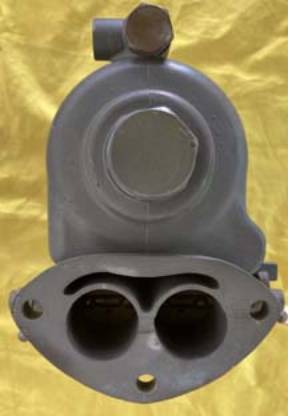
|
|
Kingston original equipment carburetor used on the 1903-1904 Ford
|
Kingston original equipment carburetor for 1904 Oldsmobile
|
Kingston prototype 2-barrel for 1934 V-8. Side view. No known
production.
|
Kingston prototype 2-barrel for 1934 Ford V-8. Bottom view. No known
production.
|
Linkert
Linkert, original known as Langsenkamp-Linkert or L & L, carburetors
were manufactured in Indianapolis. Early products included replacement
service parts for Stromberg, Carter, and Ball & Ball carburetors. There
are links with Schebler, Hawk, and Sherman; but I am unsure of the links so
these may be left to the investigation of the reader. Early Linkert catalogs
show the Linkert model LD as replacing the Schebler model D, the models M and
MR which appear to be Schebler motorcycle carburetors. A model R undraft
universal, and a model DD downdraft universal are also listed. A cabinet is
pictured which is identical to the Hawk aftermarket cabinet in style,
lettering, font, everything except the name. The cabinet is pictured under
Hawk / Sherman. As far as I am aware, Linkert original equipment carburetors
were used only by Harley-Davidson
Marvel
Marvel is another one of the older carburetor companies. I have records of
Marvel carburetors for original equipment use from 1910~1939. Many early
Marvel carburetors used the Marvel Heat Control System, which basically
routed the air/fuel mixture through a tube inserted into a chamber which was
part of the exhaust system. A dash control provided the operator a method to
control the amount of heat. Buick was Marvel's largest customer, beginning in
1912, and exclusively from 1914~1933. In 1934, Buick added Stromberg as a
second carburetor vendor, but continued to use Marvels along with Stromberg
through 1938.
|

|

|
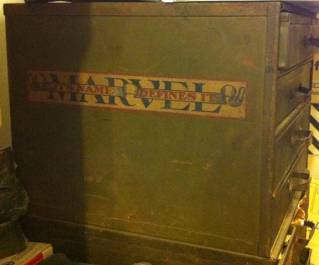
|

|
|
Marvel Sales & Service master book about 1930 back to 1916. Very
comprehensive.
|
Exceptionally rare Marvel Sales & Service bulletins. Marvel issued
bulletins on a regular basis to update the Master book. In 50 years, have
seen only 2 of these
|
One of a number of different Marvel parts cabinets. These contained an
excellent selection of jets, fuel valves, air valve springs, and other parts
|
Marvel factory carburetor tool set. Only one I have ever seen.
|
|
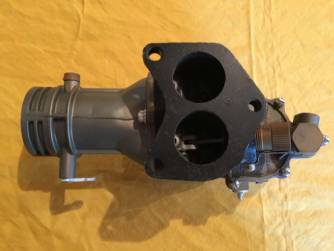
|
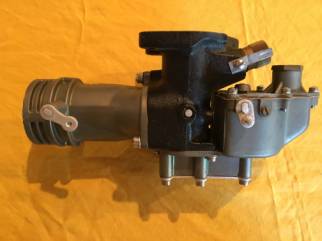
|
|
|
|
Two views of two-barrel Marvel updraft number 10-1577
|
|
|
|
Rayfield
Rayfield carburetors were produced by the Findeisen & Kropf Company,
in Chicago. While Rayfield produced some exceptionally detailed manuals for
the industry, the manuals do NOT reference if the application is original or
aftermarket; thus it is difficult to research Rayfield applications. Our
records show applications from 1910 through 1927 for original equipment.
|
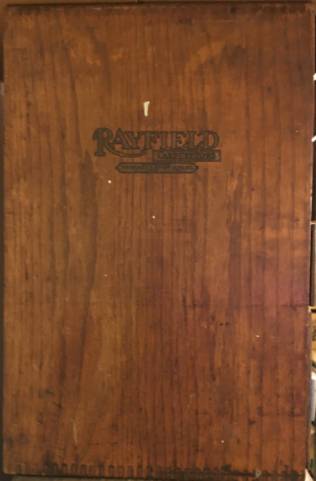
|

|
|
|
|
Two different views of a wooden Rayfield parts cabinet from circa 1915.
|
|
|
|
Rochester
Rochester Carburetor is a division of GM, and produced their first
carburetor, the type AA two-barrel, for Oldsmobile in 1949. This model
featured air intake from the back, thus lowering the total height of the
carburetor, and a gear driven accelerator pump. The type AA was discontinued
after two years of production. Rochester added a single-barrel carburetor in
1950, which was original equipment on the Chevrolet 6-cylinder for many
years. Rochester introduced the model BB two-barrel in 1951, but it survived
only a single year. In 1952, Rochester introduced the 4-Jet a.k.a. 4G a.k.a.
quadra-jet. The quadra-jet reference is not a mis-print, as the 4G series was
referred to as a quadra-jet in many Rochester documents. This has caused much
confusion among enthusiasts who know the quadra-jet as the 4M (spread-bore)
series introduced in 1965. The Rochester documentation refers to BOTH as
quadra-jets. Rochester introduced a two-barrel in the G series in 1955. The
2G, in addition to being a great home-to-market carburetor, was the backbone
of many factory multiple carburetor set-ups. The three two-barrel set-up was
introduced in 1957 by Oldsmobile on the J2 option; but made famous by Pontiac
as a "tripower". The 2G series lasted into the 1980's. In 1965,
Rochester introduced the 4M series, on the Chevrolet 396. The Quadrajet or
Q-Jet, was one of the most successful of all 4-barrel carburetors. Used
primarily by GM, Ford also used the carburetor in the early 1970's on their
429 CID.
|
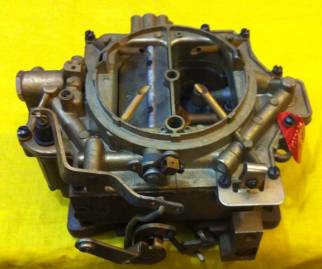
|

|
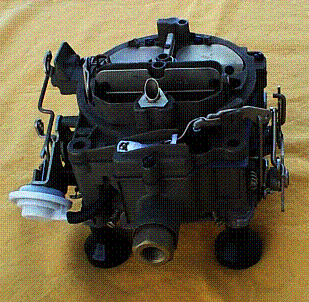
|
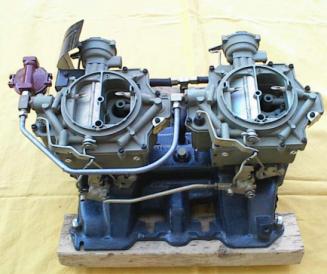
|
|
Rochester 4-barrel carburetor known a "4-Jet", "4-G"
and "Quadri-jet". Note the position of the identification tag
|
Rochester 4-barrel carburetor known a "4-Jet", "4-G"
and "Quadri-jet". Note the position of the identification tag.
Note also the position of the stamped last four digits of the tag number,
in this case 7221 from 7007221 that is SOMETIMES present, even if the tag
is not present.
|
Rochester 4-MV a.k.a. Q-Jet, Quadrajet 7028273 (Pontiac Ram Air) note
the dust cover (boot) covering the accelerator pump shaft. The choke
pull-off is a replacement, as the originals were gray and black plastic,
rather than white plastic.
|
Two Rochester type 4-GC 4-barrel carburetors used on the 1955 Cadillac
El Dorado
|
|
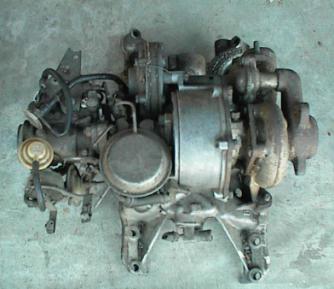
|
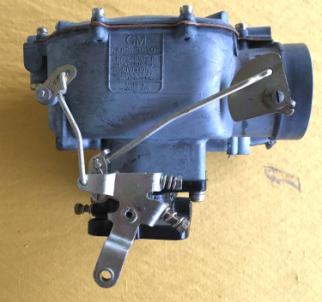
|

|

|
|
Rochester type RC sidedraft carburetor, complete with alcohol control
valve, vacuum controls, and turbocharger that was factory equipment on the
Oldsmobile Jetfire
|
The infamous Rochester "flattop" type AA used on 1949 and 1950
Oldsmobiles, Rochester's first carburetor. Always troublesome, these carbs
were discontinued after 2 years. For current enthusiasts, the solution is
the Carter WGD which, while original, was used on only a few original
applications, so sometimes difficult to find. See the Carter section.
|
Internal troublesome "innovations" used on the Rochester AA.
The accelerator pump is a gear-driven diaphragm (center). Rochester put the
diaphragm in the rebuilding kits, but mechanics had difficulty getting the
gears synchronized, so then Rochester started selling the assembled pump in
its housing (left). The vacuum piston assembly housing is cast, rather than
stamped. To my knowledge never available in the aftermarket. The enthusiast
must disassemble, and then reuse the stem and spring with a new diaphragm.
|
The Rochester type BB replaced the type AA. Used for 1 year only, on
Oldsmobile and Cadillac, and then discontinued. Rochester discontinued
making 2-barrel carbs until 1955 when they introduced the 2G series, which
continued into the 1980's.
|
|

|
|
|
|
|
Sold aftermarket by Rochester:
"The CARB-AIRATOR automatically adds air to the engine manifold to
overcome the extra rich idle mixtures caused by excessive HEAT during
prolonged periods of hot engine idling"
|
|
|
|
Schebler
Originally known as the Wheeler-Schebler Carburetor Company for its two
founders, Frank Wheeler and George Schebler. The company started
approximately 1904, and continued through the early 1930's. While
Wheeler-Sehebler was the correct name, most refer to the carburetors as
Scheblers. Most Schebler models were single-barrels, but the company did sell
an updraft two-barrel called the S-duplex in the late 1920's and early
1930's.
|
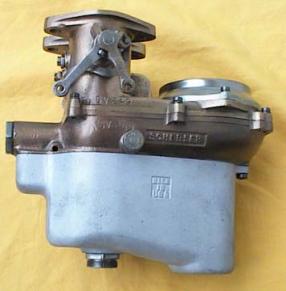
|
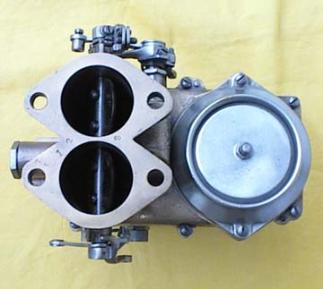
|
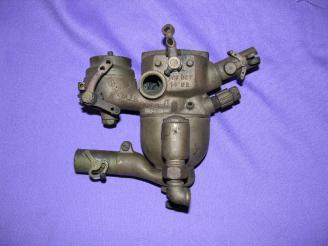
|
|
|
Two views of the Schebler S-Duplex number SX-389 used on the J
Duesenberg
|
|
Schebler model O, used on the 1913 Buick model 25
|
|
Stromberg
Stromberg started selling carburetors in 1909. The carburetor was
originally known as the "Goldberg", the name of the chief engineer,
but changed to Stromberg very quickly. Strombergs with the Goldberg cover are
quite scarce. Stromberg sold carburetors through the 1974 model year. GMC
trucks, with their V-6, was Stromberg's last customer. When GMC changed to a
re-badged Chevrolet in 1975, Stromberg lost its last customer.
|

|

|

|

|
|
"Goldberg" extremely early Stromberg bowl cover
|
Difficult to see in the picture, but under the "Stromberg
Carburetors" is the line "Formerly known as the Goldberg"
|
Wooden card file box from 1920. Stromberg issued "specification
cards" for each of their carburetors. There was a style of card for
original equipment carburetors, and another style for aftermarket
carburetors.
|
Sample specification card
|
|
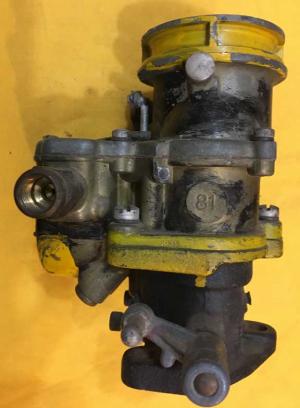
|

|

|
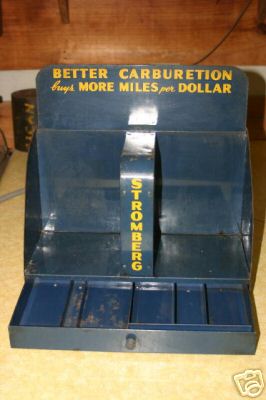
|
|
Production Master - Stromberg type EE-7/8 number A-17690, known to the
hot rod world as the Stromberg 81. Production masters were the official
calibration for the specific applications. Occasional units would be pulled
from the assembly line, and the calibration compared to the production
masters.
|
Production Master - Stromberg type EE-1 number A-18271, known to the hot
rod world as the Stromberg 97. One of the most important, if not one of the
best, carburetors ever built. In the 1930's and 1940's, salvage yards were
full of Ford V-8's, and the Stromberg EE-1's were cheap. The hotrodders
that could not afford Winfields or the specialty Rileys, used the Stromberg
EE-1.
|
Bottom of the Stromberg prototype 3-barrel from the mid-1930's,
supposedly to be used in tandem on the Cadillac V-12 engines.
Unfortunately, Cadillac discontined the engine and continued the V-16.
|
Stromberg counter-top display originally holding rebuilding kits and
gasket sets on top, with small parts (fuel valves, pumps, etc.) in the
drawer
|
|
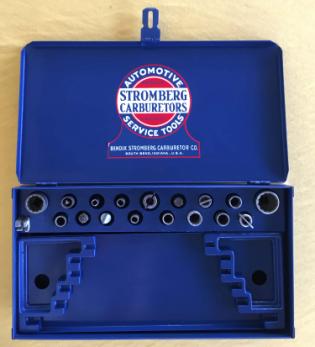
|
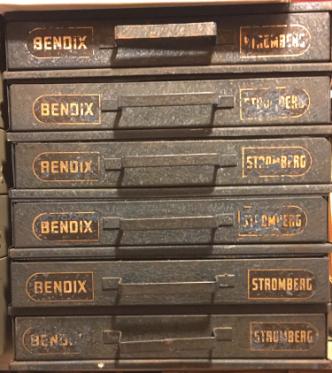
|

|
|
|
Stromberg passenger and truck carburetor tool kit from 1930's. Note the
empty positions in the tray. Stromberg offered a more expensive kit using
the same box which also contained a set of reamers. Very few kits were sold
containing the reamers.
|
Early 1930's Stromberg metal parts cabinet. Drawers were stackable, and
could be added as necessary.
|
Late 1930's Stromberg metal parts cabinet, with parts index. Drawers
were stackable, and could be added as necessary.
|
|
Tillotson
Early Tillotson literature is scarce. The earliest verifiable application
for Tillotson is 1915. There may have been earlier applications unknown to
us. While early Tillotsons were used on cars, trucks, tractors, and marine
applications; by 1935, Tillotsons were mostly used on outboard marine
engines, with a very few tractor applications. A few heavy duty carbs were
produced for the military during WWII. Post WWII, Tillotson mostly
concentrated on small engine applications.
|

|
|
|
|
|
Tillotson cabinet. The glass bottles contain a variety of screws, jets,
fiber washers, springs, etc.
|
|
|
|
Winfield
Winfield manufactured a rotary throttle carburetor for the aftermarket. I
have no record that the Winfield was used as original equipment on anything.
The Winfield caught on with the performance enthusiasts, perhaps because of
the Winfield (Ed Winfield was an extremely successful racing driver) name.
|

|
|
|
|
|
Winfield factory master catalog
|
|
|
|
Zenith
Zenith-USA is one of the older carburetor companies, that still survives
today. Early Zenith literature is scarce, and the earliest confirmed
application in my database is 1912. Zenith produced carburetors for cars,
trucks, industrial, agricultural, marine, small engine, and aircraft
applications. Zenith also produced tools, cabinets, and other related
carburetor products.
|
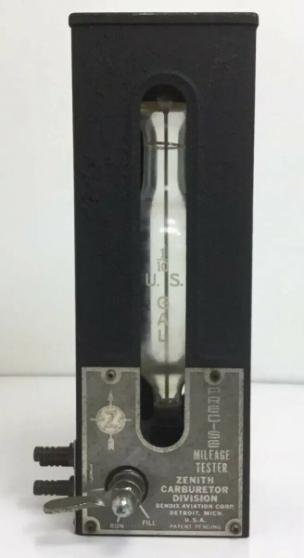
|
|
|
|
|
Zenith mileage tester. Metered a small measured amount of gasoline. This
could be attached directly to a carburetor, bypassing the fuel pump, to
determine mileage.
|
|
|
|
Lesser known
carburetor brands
|

|
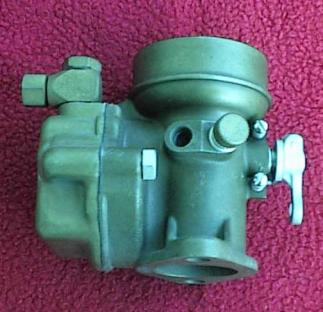
|
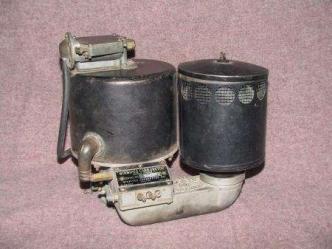
|
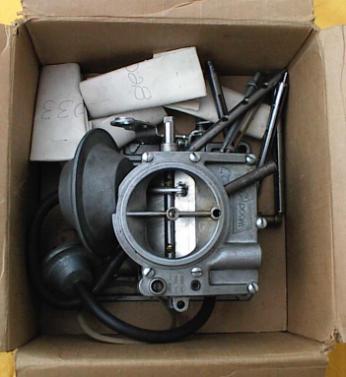
|
|
Duff Engineering patent cutaway. There is no evidence this unit made it
past the prototype stage. Note the rotary throttle which is gear driven.
|
The Fish M-1 carburetor. Will say no more!
|
The "Pogue" carburetor, manufactured by the "Winnipeg
Carburetor Company". The original ultra high mileage carburetor. In
more than 60 years of working on carburetors, have yet to speak to anyone
that had one on a running engine.
|
The Woodworth "VCCV" vacuum controlled constant velocity
carburetor. Also associated with Kendig, and the forerunner of the
Preditor.
|
|

|

|

|

|
|
Juhacz rotary throttle carburetor. A number of carburetor companies
tried to make a rotary throttle carburetor work. All of which I am aware
had part throttle and acceleration issues. Winfield was by far the most
successful, as it was used primarily for racing (wide open throttle).
|
Master rotary throttle carburetor. The only rotary throttle carburetor
that I am aware of with an original equipment application. Both Austin and
Owen-Magnetic tried a Master on factory race cars in 1915.
|
Mallory, of ignition systems fame, offered an aftermarket single barrel
carburetor in the 1930's for Chevrolet, Ford, and Plymouth 6 cylinder
engines.
|
The Penberthy Ball & Ball type DV (double venturi). If one visits
several of the various automotive forums on the internet, one will
doubtless find a reference to the first 4-barrel carburetor used by the
1918 Oldsmobile. The Penberthy Ball & Ball carburetor, like MANY other
makes, used auxiliary air valves. Somehow some enthusiasts have determined
that 2 barrels plus 2 auxiliary air valves add up to 4 barrels? even though
Penberthy advertised the carburetor in 1918 as being a double venturi.
|
|
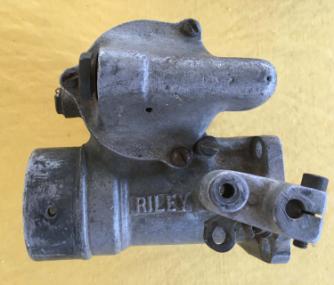
|
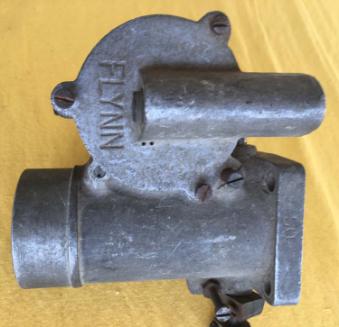
|

|
|
The Riley carburetor. A pair of these on a Ford A were the hot set-up
for those who could afford them.
|
The Flynn, which to my understanding, was a later extension of the
Riley.
|
In the early days of motoring in the USA, one of the most popular cars
was the Ford Model T. As were so many T's in comparison to other vehicles,
the aftermarket manufacturers concentrated on accessories and
"improvements" for the Model T. In fact, because of the vastness
of this market, a new phrase was born:
"fits to a T". The Sunderman Carburetor Company offered a
replacement, which had a trap-door similar to the design of some early
mouse-traps. While early advertisements do not show the "Mouse
Trap" data plate, at some time the name was given to this carburetor.
|
Ballwin-Washington
Ballwin-Washington was a company that produced a large selection of
carburetor parts for the carburetor rebuilding market. There are links to
Hawk, Sherman, Pacco, and Ace Electric as to the ownership of
Ballwin-Washington. They produced some very elaborate catalogs to market
their carburetor parts.
D & G
Valve
|
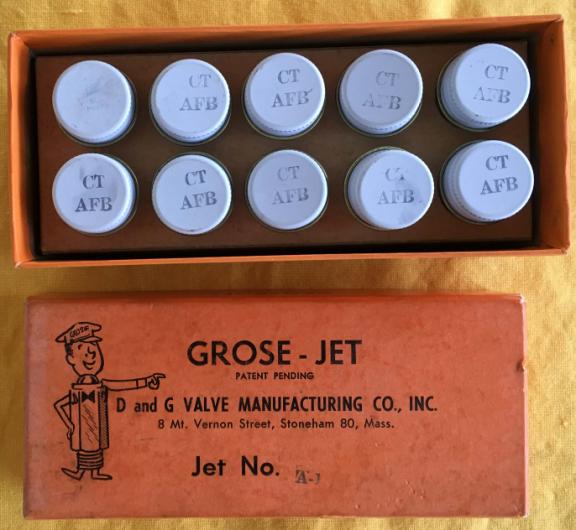
|
|
D & G Valve
sold an aftermarket fuel valve using 2 balls rather than the conventional
pointed valve
|
Hawk / Sherman
Hawk and Sherman, like Ballwin-Washington, were suppliers of carburetor
parts to the carburetor rebuilding industry. Additionally, Hawk offered a
retail cabinet of a vast selection of carburetor parts.
|
|

|

|
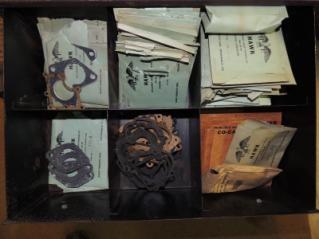
|
|
The Hawk retail cabinet and contents
|
|
|
|
Hygrade
Hygrade was probably the best well-known, and had the widest selection of
aftermarket carburetor parts beginning in the 1930's. In addition to
carburetor parts, Hygrade offered tool sets, retail cabinets, retail
rebuilding work stations, and some fabulous cataloging.
|

|
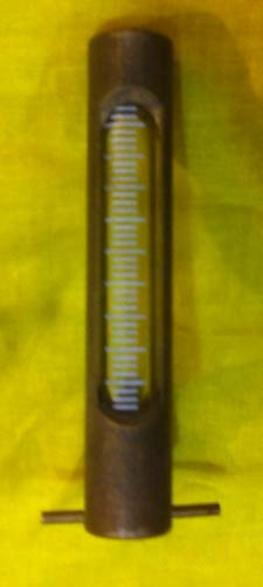
|
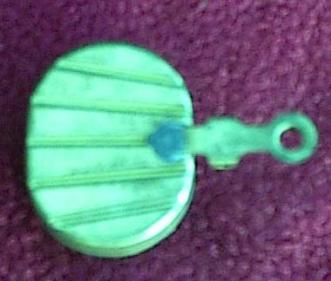
|
|
|
Two views of the Hygrade float adjustment gauge for updraft carburetors.
The fitting was screwed into the bowl drain hole in the carburetor, and the
fuel level in the bowl would be displayed in the glass tube. The technician
could take measurements, then remove the bowl cover and fuel valve and make
adjustments.
|
|
Hygrade aftermarket brass float for early Marvel carburetors, replacing
the troublesome cork float.
|
|
|

|
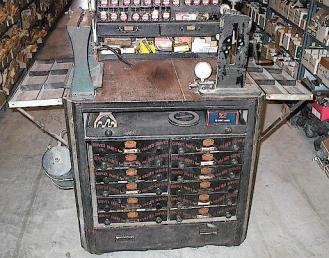
|

|
|
|
Three views of the Hygrade Specialized Service workstation. The work area is appoximately 32 inches tall.
The entire workstation is more than 6 feet tall. There is a foldable parts
tray on each side, a pedestal where carburetors may be mounted, a tank for
either air pressure or vacuum, and a fuel pump tester (on the right). The
first drawer under the work area contains a number of special tools
produced by Hygrade. The rest of the drawers are full of carburetor, fuel
pump and speedometer rebuilding parts, as are the glass jars.
|
|
|
|
Parker
Brothers
|
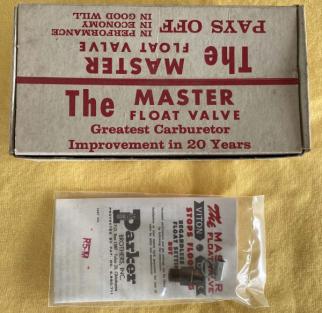
|
|
Parker Brothers marketed an aftermarket fuel valve which featured an
aluminum plunger (non-magnetic) with an embedded neoprene disc that sealed
against and inverted flare fitting. This was called the "Master Float
Valve".
|
Vernay
The Vernay Corporation produced fuel valves (a.k.a. needle and seat
assemblies) with the neopreme tip for carburetors. As their market was
wholesale only, to the carburetor companies, and the aftermarket repair kit
companies, memorabilia is scarce. However, they did produce an interesting paperweight.
This is a transparent plastic cube of 2 1/2 inches.
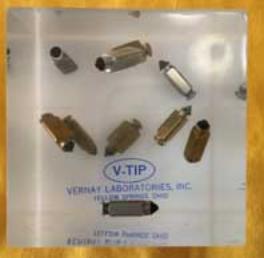
|























































































